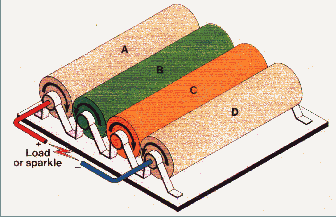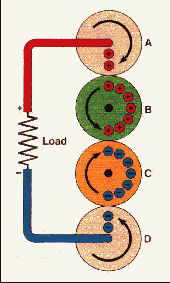

Lorente's Electrostatic Generator or Machine is anew device for high voltages very suitable for education. Awarded with the great Price ofInternational Jury in the Eureka-Brussels Saloon of inventions (1.991). US patented(#4990813). Patent available for sale. Main applications This generator is particularly suitable for electrostatic demonstrations and experiments in the school. The prototypes made and tested provided voltages in the range of 30.000-50.000 Volts, with currents of a few microamperes. Therefore it is a proper instrument, as voltage source, for most of classical experiences in Electrostatics. Moreover operations are free of human risks for these values of voltage and current. We hope that new developments will prove to be very adequate for other applications like, X-rays, particle accelerators and excitations of gas tubes. In the Science House This generator is most suitable for the interactive and participative devices now in use in Science House and Interactive Scientific Museums. Some projects in this direction are now in progress. Advantages Due to the simplicity of its design it is not exposed to mal adjustmentor failures. Every operator knows the difficulty of making the "mise au point"of some classical electrostatic generators. The dependence of humidity is lower in this generator then in other ones. Because of the simplicity of its design it could also be manufactured at very low cost, for large number of copies. Description It consists of four equal cylinders or rollers with their axes parallel to each other and with their surfaces kept always in contact by mean of springs. All the axes are in the same plane. They are able to rotate, without friction, remaining always in contact each cylinder with the lateral ones. The two external rollers are metallic and the two internal ones are of suitable plastic materials, but of dissimilar nature. In my models I selected teflon and nylon (because they occupy extreme opposite places in"electrostatic series"). Operation For operation a driving force is applied to one of the rollers eitherby hand or with a motor. Because of this action all rollers rotate in close contact but without mutual friction. In the fringe of contact between teflon and nylon teflon receives electrons from the nylon. The surfaces of dielectric rollers so became charged respectively with electric charges of opposite signs. Because teflon and nylon are insulators, charges remain fixed where created and they do not diffuse in the bulk of material. Afterwards when the charges get in touch with metallic cylinders they migrate to them and from them, through the metallic bearings into external terminals of positive and negative sign respectively. Prototypes. Several prototypes have been made and tested. The diameter of the cylinders were 10 cm in some of them, 5 cm in other ones. A very small number of them could be available. Inventor. Professor Dr. Gabriel LORENTE. He belongs to the "UniversidadNacional de Educación a Distancia", Madrid (Spain). Dr. Lorente is a Physicist,specialised in Electromagnetic Fields and Wawes and a researcher in experimental electrostatics. Co-operative research. Professor Gabriel LORENTE should be happy to contact other scientists interested in this area and to plan some co-operative actions of research. Find his address at the end of this page. Patents. Lorente's Generator or Machine is patented in U.S.A. (nº 4990813) andin the European Union (nº 3665911). The assignee for both patents is the UniversidadNacional de Educación a Distancia (U.N.E.D.) Patents available for sale or license. Offers of manufactures interesested in purchasing the patent rights orgetting a license will be welcome by the assignee. Contact addresses of Prof. Gabriel Lorente e-mail: glorente@ind.uned.es fax +34-1-3986536 phone +34-1-3986431 (only for spanish language) postal address: Dep. Mecanica.(ETS. Ingenieros) Universidad Nacional de Educación a Distancia Ciudad Universitaria. 28040 Madrid (SPAIN) New Electrostatic Generator, US Patented



other related electrostatic type web pages.
Make you own high voltage capacitor simply with this winding jig
A free engine machine using electrostatic principles
The wimshurst electrostatic machine with spinning disks
the ahmedov excess energy device
